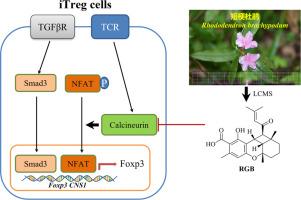Phytomedicine ( IF 6.7 ) Pub Date : 2023-05-23 , DOI: 10.1016/j.phymed.2023.154898 Chang-An Geng 1 , Feng-Yang Chen 2 , Jing-Bin Zheng 3 , Ping Liao 3 , Tian-Ze Li 1 , Xue-Mei Zhang 1 , Xin Chen 4 , Ji-Jun Chen 5

|
Background
The accumulation of CD4+Foxp3+ regulatory T cells (Tregs) in the tumor microenvironment (TME) dampens anti-tumor immune responses and promotes tumor progression. Therefore, the elimination of Tregs has become a strategy to enhance the efficacy of tumor immunotherapy, although it is still a daunting challenge. Rhododendron brachypodum (R. brachypodum) is a perennial shrub mainly distributed in Southwestern China, whereas the chemical constituents in this plant remain elusive.
Purpose
To identify small-molecule inhibitors of Tregs from R. brachypodum.
Methods
Meroterpenoids in R. brachypodum were isolated by column chromatography under the guidance of LCMS analyses. The structures of isolates were identified by spectroscopic data and quantum calculations. The activities of compounds were first evaluated on CD4+ T cell differentiation by flow cytometry in Th1, Th2, Th17, and Treg polarizing conditions, and then on CT26 and MC38 murine colorectal carcinoma cells-allografted mice models. The mechanism of action was first investigated by determining Foxp3 degradation in Jurkat T cells transfected with pLVX-TetOne-Puro-Foxp3-tGFP, and then through analyses of Foxp3 expression on several pre-transcriptional signaling molecules.
Results
Two new prenylated phenolic acids (1 and 2) and a chromane meroterpenoid, rubiginosin B (RGB, 3) were obtained from R. brachypodum. The structure of S-anthopogochromene C (1) was rectified according to the electronic circular dichroism (ECD) experiment, and rhodobrachypodic acid (2) was proposed as the precursor of RGB by photochemical transformation. In this investigation, we first found that RGB (3) selectively suppressed the de novo differentiation of TGFβ-induced CD4+Foxp3+ regulatory T cells (iTregs), overcome the immunosuppressive TME, and consequently inhibited the growth of tumor in mouse models. The mechanistic study revealed that RGB could target calcineurin, inhibited the nuclear factor of activated T cells (NFAT) dephosphorylation, and down-regulated Foxp3 expression. The hypothetical binding modes of RGB with calcineurin were predicted by molecular docking, and the interactions were mainly hydrophobic effects and hydrogen bonds.
Conclusion
These results suggest that RGB enhances anti-tumor immune responses by inhibiting Treg cell differentiation through calcineurin-NFAT signaling pathway, and therefore RGB or its analogs may be used as adjuvant agents meriting further investigation.











































 京公网安备 11010802027423号
京公网安备 11010802027423号